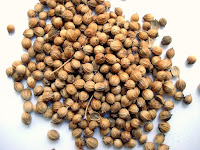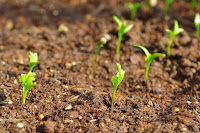Written By Peter Otieno
Coriander is a green leafy herb popularly known as dhania in Kenya and is used as a spice in stews and kachumbari.
Kachumbari is a salad made by mixing freshly chopped tomatoes, onions, chili pepper and coriander leaves.
It has a pleasant aroma and adds flavor to foods which makes it a favorite spice.
Coriander has a short period of maturity that is from six to eight weeks and can easily be grown in pots and buckets apart from the farm.
It grows in well drained soil and requires enough sunlight and water for germination.
Dhania's flexibility allows it to be grown in different ways which include:
1. In pots and buckets - this is suitable for persons who live in urban centers and have a small space.
2. In green houses - for farmers who are into large scale and commercial farming.
3. In seedbeds - for small scale farmers and individuals that grow for home consumption.
In this article, we will focus on growing coriander in a seedbed. The steps are as follows:
Getting Seeds
For a start, go to an Agro vet store in a town or market near you and buy Dhania seeds.
They come in different sizes and prices from as little as a hundred Kenya shillings hence it will depend on the size of land you have prepared.
 |
| Coriander seeds |
The best seeds are from Simlaw Seeds and Kenya Seed Company here in Kenya and take into account that the seeds have not lasted more than six months since their day of manufacturer.
This will determine the percentage of seeds that germinate after sowing.
Land Preparation
First, ensure your seedbed is in an area where its not directly hit by sunlight such as under a tree or you can build a shelter around your seedbed.
Next, using a rake and a member prepare your land to a fine filth.
Dig small shallow furrows each 20cm apart and with a depth of 3cm. See picture illustration.
👉
Sowing Seeds
First, add coriander seeds in a small container then sprinkle a bit of sand and mix in the container.
This will avoid crowding of seeds thus enabling even distribution of seedlings once they sprout from the ground.
Second, you can use seed propagation. This involves planting each seed in a tray and once they sprout you transplant them. See picture below.
Add organic manure on each furrow then sow seeds and cover with little soil. Organic manure adds nitrogen and phosphorus required by seedlings.
Finally, add mulch to your furrows then sprinkle water. Mulching retains moisture and prevents washing away of seeds after watering.
After 8 to 10 days, coriander seedlings will start to germinate and here you can remove your mulch.
Irrigation
Water dhania plants after every three days once they sprout and skip irrigating when it rains. Furthermore ensure coriander seedlings absorb enough sunlight and take up required amount of water as excess water will minimize growth and direct sunlight will cause withering of leaves.
Controlling Weeds
This is done a week after germination and in the fourth, fifth and sixth week. You can do this either by uprooting weeds competing with plants or thin plants when they reach 8 to 12cm in height.
Seedbed Hygiene
Weeding helps control pests like aphids and diseases such as powdery mildew and bacterial leaf spot which may affect coriander leaves.
I strongly recommend use of organic manure and as a top dressing fertilizer for more nitrogen fixation and large dhania leaves. Apply at four weeks of maturity and before harvesting.
Harvesting
Coriander takes 6 to 8 weeks to mature. At this point they will have reached a maximum height of about 24 cm.
Coriander will have dark ripe green leaves and produce a pleasant aroma.
When harvesting begin with larger dhania plants and allow smaller ones to grow.
 |
| Coriander ready for harvest |
Do not let your coriander to overgrow as they will start turning yellow and appear feathery.
Harvest early in the morning for a fresh delivery to customers.
Storage
After harvesting, soak coriander roots in water to keep them fresh and they should be under a shade.
If you want to keep some for family consumption, store dhania in a freezer (wash, cut the roots, then wrap the stems and leaves in a paper cloth or ziplog bag, put in a container, cover and store in your freezer) but they should not last more than ten days.
Benefits From Coriander
Coriander contains vitamin K that helps in blood clot and bone repair.
Dhania seeds lower blood sugar levels in people who have diabetes.
It is known to reduce swelling and inflammation in parts of the body due to Omega-3 fatty acids present in the leaves.
Its antioxidant properties slow growth of cancerous cells and fight free radicals(loose oxygen molecules that can damage your cells) in your bo body.
Dhania helps in removing excess water and sodium in our body thus lowering blood pressure reducing risk of heart disease.
My Conclusion
Coriander is always in high demand with a kilo going for 50 to 100 Kenya shillings when you sell.
Sell your harvest to direct consumers, hotels and restaurants as they are the major buyers of coriander.
Coriander farming can generate income, so if you want to stay in the market you can grow them in lots or batches so that you do not run out of stock to sell.
Apply spacing when sowing seeds for uniform growth as dhania tends to be bushy as it grows.
As a herb, coriander fragrance and aromatic flavor makes it a must have spice in foods, soups and salads. Is it the spice for you?
For more article check simple-way-to-grow-scallions-or-green.




Kachumbari sounds tasty, I look forward to trying it. Thank you.
ReplyDeleteA most definite try and you'll love it.
ReplyDeleteThis blog give infromation about coriander
ReplyDeleteधनिया की कटाई)